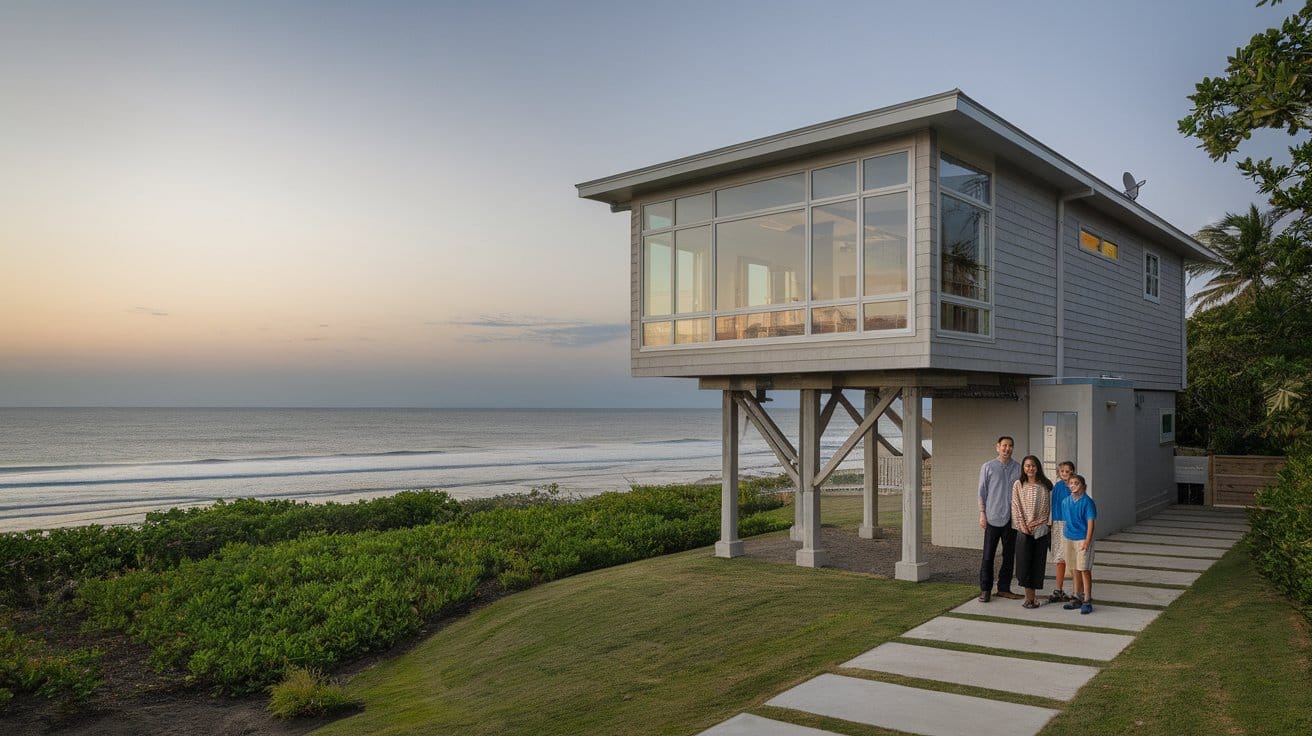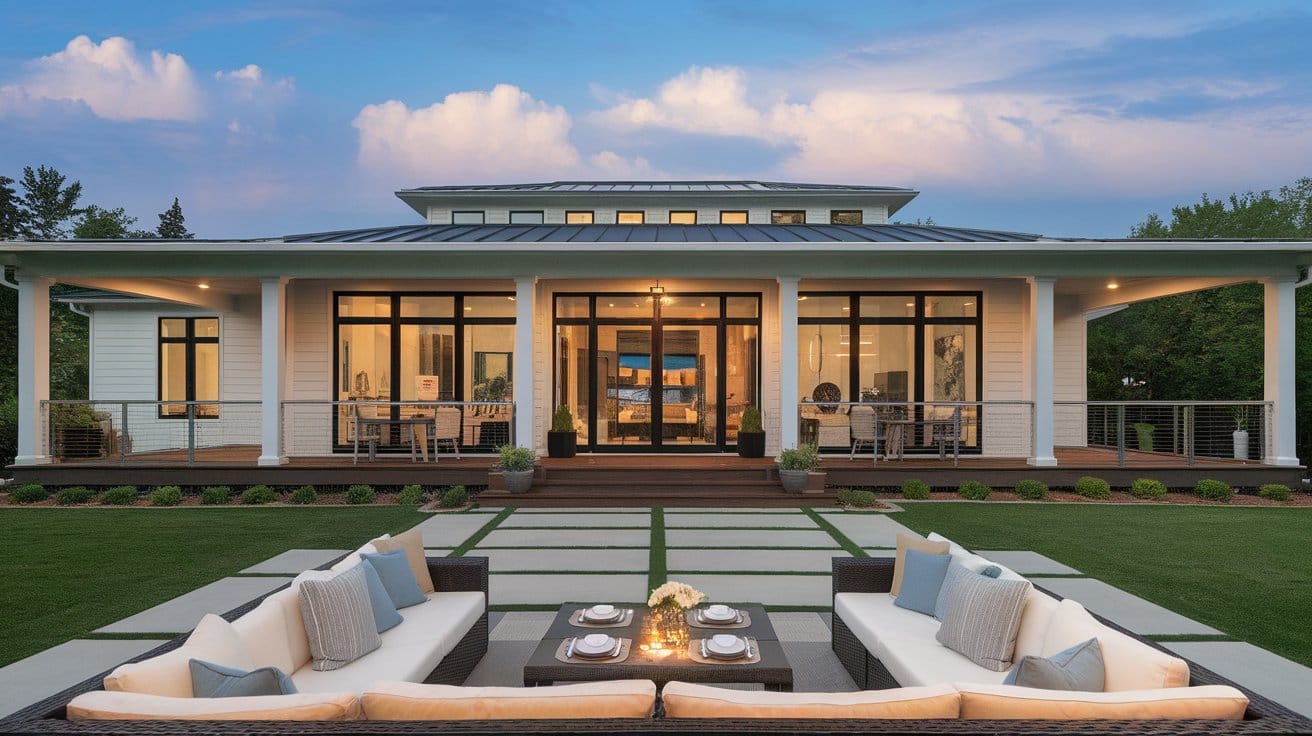Introduction
Open floor plans have transformed modern home design, offering homeowners a sense of openness and flexibility. By removing walls that traditionally separated rooms, these layouts promote better traffic flow and allow for more fluid interactions among family members. Without barriers, areas such as the kitchen, dining room, and living space can blend into one, creating an inviting and functional environment perfect for family gatherings and entertaining guests. Open concept floor plans are also ideal for maximizing natural light, which can make even smaller spaces feel larger and more welcoming.
However, with the many benefits of open floor plans come some challenges. Privacy and noise management can be more difficult in an open layout since the removal of walls reduces sound barriers and personal spaces. Homeowners considering an open floor plan house will want to consider strategies for maintaining a peaceful atmosphere, such as incorporating noise-reducing materials or creating distinct zones with furniture placement. Thoughtful design can ensure you enjoy the many advantages of an open floor plan without sacrificing comfort or tranquility.
Key Takeaways
Open floor plans promote better traffic flow and flexibility by removing walls that traditionally separate key areas like the living room, kitchen, and dining room.
The lack of barriers in open layouts allows for an increase in natural light, which can make spaces feel larger and more inviting.
Open-concept designs offer enhanced flexibility for furniture placement and decor, allowing homeowners to adapt the space to their lifestyle.
Privacy can be a challenge in open floor plans, but design solutions like furniture arrangements and dividers can help create more personal spaces.
Noise control is a concern in open layouts, but sound-absorbing materials like rugs and curtains can help mitigate this issue.
Open floor plans provide an ideal setup for integrating multi-functional spaces, making it easier to combine work, relaxation, and entertaining within the same area.
Benefits of Open Floor Plans

Open floor plans have become a popular trend in modern home design, and for good reason. They offer a seamless transition between the living room, kitchen, and dining areas, creating a more spacious and inviting environment. Without walls to hinder traffic flow, these layouts allow for better movement within the home, making social gatherings and family time more enjoyable. Additionally, an open-concept floor enhances the overall feel of your space, making it ideal for entertaining guests or keeping an eye on the kids while preparing meals. This design style also maximizes square footage, making even smaller homes feel larger and more efficient.
Benefits of Open Floor Plans in Modern Scandinavian Open Floor House Plans
Open floor plans are a hallmark of Scandinavian design, blending functionality and simplicity with natural elements to create cohesive, airy spaces. These layouts promote a seamless connection between living spaces while maximizing natural light and flexibility. Let’s explore the core benefits of this design concept in the context of modern Scandinavian homes.
1. Maximized Natural Light
Open floor plans in Scandinavian homes remove barriers, allowing sunlight to travel freely throughout the interior. This design element enhances the home’s natural brightness, minimizing the need for artificial lighting. Scandinavian climates, often marked by long, dark winters, benefit greatly from this feature, making homes feel more inviting and improving the overall well-being of residents by increasing exposure to natural light.
2. Enhanced Space Flexibility
A key feature of Scandinavian open floor plans is their flexibility. Without walls, homeowners have the freedom to rearrange furniture and create multifunctional spaces that suit their changing needs. Whether it’s turning a living area into a workspace or seamlessly transitioning between kitchen and dining spaces, this adaptability ensures the home remains practical for various activities without feeling cluttered.
3. Promotes a Harmonious Flow
Scandinavian design emphasizes simplicity, and open floor plans support this by eliminating unnecessary divisions between rooms. The absence of barriers allows for smooth traffic flow, enhancing the sense of togetherness in family life. This creates a more harmonious living environment, encouraging social interaction and making it easier for parents to keep an eye on children, all while preparing meals or hosting guests.
Enhanced Natural Light
One of the most notable benefits of open floor plans is the increased natural light they provide. By removing interior walls, sunlight can travel freely throughout common areas like the living room and dining room, brightening up the entire space. This natural lighting can significantly reduce the need for artificial lights during the day, saving energy and creating a more environmentally friendly home. A brighter interior also boosts the ambiance, making it feel welcoming for both residents and guests. Additionally, natural light contributes to a healthier living environment, improving mood and productivity.
Increased Space and Capability
Open floor plans offer greater flexibility in how you use your home’s space. With fewer walls, homeowners can reconfigure furniture and decor to suit their lifestyle, whether it’s for entertaining guests or creating a cozy family room. This flexibility allows for better traffic flow between rooms like the kitchen, dining room, and living room, making it easier to socialize without interrupting activities. Moreover, the open-concept layout makes a home feel less restricted, allowing for smoother transitions between different areas. For families, it’s especially beneficial to keep an eye on the kids while multitasking in various parts of the house.
Key Elements of Scandinavian Design

Scandinavian design has gained worldwide popularity for its clean, minimalist approach, which emphasizes functionality, simplicity, and beauty. This design style focuses on creating spaces that are not only visually appealing but also practical. By eliminating unnecessary clutter, Scandinavian homes feel open, airy, and filled with natural light. The use of neutral tones, combined with carefully selected natural materials, enhances the sense of spaciousness in both large and small spaces. Additionally, the design principles encourage a seamless connection between indoor and outdoor environments, making it a perfect fit for open-concept floor plans that allow for smooth traffic flow and maximum usability.
Case Study: The Impact of Open Floor Plans in Scandinavian Design
In a recent case study focusing on a modern Scandinavian home, the integration of an open floor plan dramatically improved the living environment by promoting natural light and creating a spacious, harmonious atmosphere. The removal of interior walls allowed sunlight to flood the home, reducing the need for artificial lighting and contributing to a sustainable, energy-efficient design. By incorporating natural materials such as wood and stone, the homeowners achieved a warm, inviting interior that maintained Scandinavian principles of minimalism and simplicity. This open-concept layout also facilitated seamless movement between living spaces, enhancing both functionality and social interaction within the home.
Minimalism and Simplicity
At the heart of Scandinavian design lies a strong focus on minimalism and simplicity. Every element in the space is carefully chosen for its functionality and aesthetic appeal. Clean lines, neutral colors, and open spaces create an uncluttered, serene environment. Whether it’s the placement of a dining room table or the use of a great room, the aim is to make the space feel larger and more inviting. By integrating simple furniture and decor, Scandinavian design maximizes both comfort and style without sacrificing practicality. This approach complements open-concept floor plans by enhancing the overall sense of flow and spaciousness within the home.
Use of Natural Materials
Natural materials are a fundamental aspect of Scandinavian design, adding warmth and texture to the minimalistic interiors. Wood, especially light-colored varieties, is often used in flooring, ceilings, and furniture to create a cozy atmosphere. Stone and natural textiles like wool and linen are also commonly incorporated to further connect the indoors with nature. These materials not only enhance the aesthetic appeal but also contribute to the home’s sustainability. In an open floor house plan, natural materials blend seamlessly across spaces, tying together the living room, dining room, and kitchen into one large, harmonious area that promotes relaxation and comfort.
Designing an Open Floor Plan: Space Optimization

Designing an open floor plan requires thoughtful consideration to make the most of the available space while maintaining both functionality and style. Open concept layouts remove walls between key areas like the living room, kitchen, and dining room, encouraging better traffic flow and a sense of spaciousness. However, it’s important to optimize the space so it doesn’t feel too empty or overwhelming. Smart design elements, like careful furniture placement and integrating multi-functional areas, can transform the layout into a cohesive and flexible living environment. Homeowners can enjoy a space that feels expansive while still being able to entertain guests or relax with family in distinct areas.
Zoning with Furniture Placement
One of the key ways to maintain order in an open floor plan is through strategic furniture placement. By using furniture to define zones, such as placing a couch to separate the living area from the dining room, homeowners can create a sense of structure within the open space. Adding area rugs under dining tables or seating areas further reinforces these zones, helping to anchor each section of the room without walls. This method not only enhances the flow of the room but also makes each zone feel purposeful and comfortable. Whether it’s the living room or kitchen, smart furniture placement is essential for optimizing the use of space.
Integration of Multi-functional Spaces
Another advantage of open floor plans is the seamless integration of multi-functional spaces. For instance, a kitchen island can double as both a prep space and a casual dining area. Similarly, a corner of the living room can serve as a home office or a cozy reading nook, making the most of every square foot. These multi-functional areas add versatility and flexibility to the home design, catering to the dynamic needs of modern living. With careful planning, homeowners can optimize their space without compromising on style or comfort, creating an inviting atmosphere that supports various activities, from entertaining to working at home.
“Space and light and order. Those are the things that men need just as much as they need bread or a place to sleep.” – Le Corbusier
Challenges of Open Floor Plans

While open floor plans are praised for their spaciousness and modern feel, they also present certain challenges that homeowners should consider. The absence of walls allows for seamless flow between rooms like the kitchen, dining room, and living space, but it can also lead to issues with privacy and noise. It’s essential to think through how these challenges might affect daily living and explore design solutions that maintain the openness while addressing these concerns. By being mindful of how to manage privacy and sound, homeowners can enjoy the benefits of open-concept designs without sacrificing comfort.
Privacy Concerns
One of the most significant drawbacks of open floor plans is the lack of privacy. Without walls, there is little separation between spaces like the living room, kitchen, and dining area. This openness can be great for socializing, but it may be challenging for family members who need solitude or quiet time. In homes with multiple people, it can be tough to find a private spot for activities like working or reading. To counteract this, homeowners can incorporate design elements like large plants, furniture arrangements, or even partial dividers to create designated zones that offer some level of privacy while still keeping the space visually open.
Noise Management
Another common issue in open floor plans is noise control. Without walls to contain sound, noise from one area can easily travel to another. For example, the sounds of cooking or cleaning in the kitchen can disrupt conversations or relaxation in the living room. This can be especially problematic in busy households with kids or multiple activities happening at once. To address this, homeowners can use noise-absorbing materials such as curtains, area rugs, and upholstered furniture. These additions help soften the sound and create a more peaceful environment, making it easier to enjoy the spacious feel of an open-concept design without the constant disruption of noise.
Conclusion
In conclusion, open floor plans offer homeowners the ability to create a spacious, flexible environment that seamlessly integrates key areas such as the kitchen, dining room, and living space. By removing traditional barriers, these layouts encourage togetherness, allowing for better traffic flow and maximizing the use of natural light. However, thoughtful design considerations such as strategic furniture placement, noise management, and creating designated zones can help address common challenges like privacy and noise control.
Whether you’re planning a renovation or designing your dream home, an open concept house plan provides many options for interior design and space optimization. With the right approach, this layout allows for multi-functional spaces, making your home ideal for both family gatherings and daily life. From choosing built-in fixtures to selecting the perfect paint colors, open floor plans offer endless possibilities for creating a trendy, comfortable, and welcoming home.

![CLOUDY BAY [6 Pack] 6inch Smart WiFi LED Recessed Lights,RGBCW Color Changing Recessed Lighting,Compatible with Alexa and Google Home Assistant,No Hub Required,15W 2700K-6500K,CRI90+ Wet Location](https://m.media-amazon.com/images/I/41H5465vC2L.jpg)




